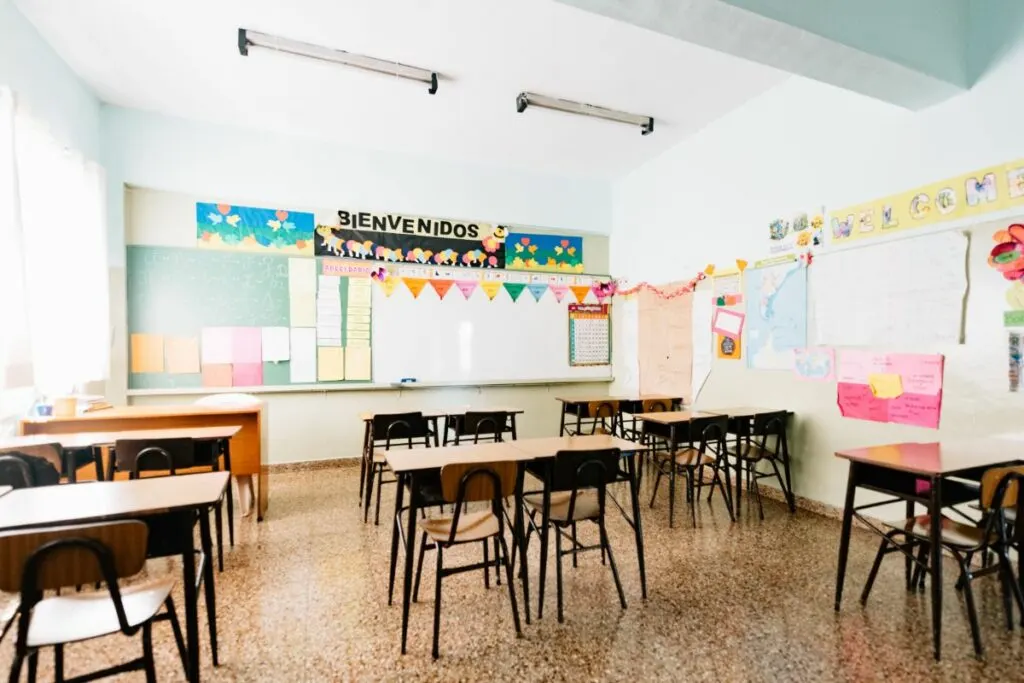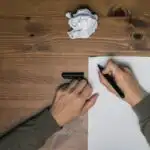Chances are that if you’re a teacher in this day and age, you’re feeling the pressure when it comes to making your classroom as ‘aesthetically pleasing’, as possible.
There’s so many teacher classroom goals flying around on social media, that it’s easy to feel inadequate when it comes to the presentation of your own teaching space.

Some of the intricate charts we see online lead us to question, where do people even have the time to make these? Between the actual teaching, grading, admin, and lesson planning, making elaborate displays seems absolutely impossible.
We have, however, found one chart that is super easy to complete, incredibly effective in the classroom, and is quick to put together – the anchor chart.
These will truly make your classroom space feel and look Pinterest-worthy, and can be a massive aid when it comes to visual teaching in your classroom.
In this guide, we’ve compiled everything you need to know about anchor charts, and the most effective way to use them within the classroom.
To find out more, simply keep reading below, as we take a closer look together.
What Are Anchor Charts?
Now, before we jump straight in and give you all of the tips you need to get started with your own anchor chart, let’s cover what this classroom tool really is, for those who don’t know.
For those of you who have never heard of anchor charts before, they’re essentially a teaching aid that can help you to demonstrate key points, and important reminders from different lessons.
This is why they are called ‘anchor’ charts, because they can help to anchor key information that your students need to memorize.
You can also highlight any strategies that your students can use to memorize these different key points, and they can therefore be an incredibly effective tool in informational retention.
Some anchor charts that teachers use are available for the whole classroom to fill in, so that everyone has the opportunity to contribute. This can help you to gain a greater understanding of who’s grasping the work, and who might need a little bit more help.
Anchor charts are multi dimensional, and can be used for each different discipline, including English, math, science, and history. They can also be used across several different grades.
After you’ve completed your anchor chart, and have worked at making it colorful and visually appealing, you can then go ahead and hang it up in your classroom.
It should be in a visible area, where the children can see it clearly, and be reminded of everything that they’ve learnt.
This will be useful for future examinations and assessments.
The Reasons Why Anchor Charts Are So Great
There is a reason why you’re seeing more and more anchor charts being hung up in teacher’s classrooms everywhere, and that’s simply because they carry so many different benefits.
They not only look great and brighten up your work space, but they’re also incredibly effective teaching tools.
One of the best things about anchor charts is that they can work really well as an introductory device to a certain lesson or topic.
Delving into something new with your students can be difficult, and so having a visual anchor from the very beginning can make it much easier to illustrate what you want to convey. Research has actually shown that anchor charts are excellent when it comes to building a foundation for new material.
In addition to being a great introductory tool, they’re also fantastic when it comes to solidifying information that you’ve taught during a particular lesson. You can write down all of the key points that you’ve just covered so that they can retain the information long after the lesson has finished.
In addition to this, anchor charts may be beneficial for children who struggle with attention span, and need lots of visual information in order to stay interested.
They will help to guide these students through new topics and concepts, all the while keeping them preoccupied with the visual components.
How Do I Make Anchor Charts For The Classroom?
This brings us to our next question, which I’m sure you’re all dying to know about at this stage. Just how do you make an effective anchor chart for your classroom?
Well, this isn’t all that easy to explain or illustrate, purely because as we mentioned earlier, each anchor chart is different, and each teacher will have their own manner of approaching these.
There are, however, a few key steps and tips that you can follow in order to get started with making your own anchor chart.
The first tip that we’d give you, is to simply have a clear picture in your head of the module you’d like to teach, and some of the key take outs that you’d like your students to get from the lesson.
Once you know the objective, it will become easier to think about some additional add-ons that you’d like to include in your anchor chart.
Some Tips For Making Your Anchor Chart
Now, we’d like to give you some tips that you can follow in order to get started with your own anchor chart, keep reading below to find out more.
Use Lots Of Color
The first tip that we’d like to give you is to simply use lots of color when it comes to making your anchor charts. Remember that you want to make these as visually appealing as possible, and using lots of nice, bright colors will help your students to stay engaged for longer.
You can also use color to separate different topics or modules that you’re teaching. For example, science can be green, English red, and history yellow.
Make Them With Your Students
You don’t have to spend all of your time creating the anchor charts yourself, instead, see this as a good opportunity to engage with your students, and create a learning device together.
This way, students are much more likely to engage with what’s going on, because they’re actually a part of it all. You can ask them at the end of each class what they thought were the most important takeaways from the lesson, which you can then utilize to include on your anchor chart.
You don’t have to have the students actually write on the anchor chart itself, if their handwriting is difficult to understand, but instead they could write their point on the whiteboard, which you can then transfer yourself.
Make It Aesthetically Pleasing
When it comes to anchor charts, remember that these devices are something that you’re going to be looking at each and every day. So, it’s important to make them as engaging and visually appealing as possible.
In order to do this, the best thing you can do is to make sure that they’re as simple and clear as possible. Putting too much information on your anchor chart can make it appear cluttered, and drive away from the aesthetic quality.
You can also make your chart look as great as possible by stenciling everything out with a pencil before delving in. Then, you can make sure that everything looks just right before making any permanent drawings.
We would also recommend that you use a projector in order to create your anchor chart. You can use this to create special graphics, or different fonts, and you can trace all of these yourself.
Use Lots Of Pictures
We’d recommend that you make sure to find a good balance between words and pictures. You want to make sure that your chart isn’t cluttered with too many words, as this will cause your students to become bored.
This can help to create a memory path that will take your student’s brains back to the actual lesson.

Tools To Use For Anchor Charts
Now that we’ve covered some of the key points you can use in order to create the very best anchor chart, we can move on to discuss some of the different supplies you can use.
The best thing about anchor charts is that you won’t need a whole lot of things in order to get started, chances are you’ll already have all of these lying around.
We would recommend that you buy a large paper chart, as well as some pencils to sketch out your designs. As well as this, you will also need some markers in various different colors, in addition to a projector which you can use to sketch out your different ideas.
How To Hang Up Anchor Charts
Now we can move on to discuss one of the challenging aspects surrounding anchor charts, just how do you hang these up? This can be especially tricky depending on what kind of walls you have in your classroom.
Cinder block walls, for example, can prove to be difficult, and can cause your charts to fall down more easily.
Well, there’s no need to worry, because there are several different ways that you can hang your anchor charts, no matter what kinds of walls you have in your classroom.
The first thing that we’d say, before hanging up your anchor chart, is to choose an appropriate place in the classroom where your students will be able to see it clearly each and every day.
Once you’ve decided where you’d like to place your anchor chart, the next step is to hang it up. One of the best ways to do this is to simply try some command hooks. These can be super useful if you want to utilize your board space.
You can also purchase magnetic hooks, so that you can take your anchor chart off the wall when need be, which is super useful if you’re using a temporary classroom space.
If using hooks isn’t really appropriate, then you could hang up your anchor chart using a curtain rod instead. Choose a super thin curtain rod, and to metal hooks to attach it to the wall on either side.
Another great way to hang up your anchor charts is using a hot glue gun. This is great if you’ve got cinder blocks, and aren’t able to attach hooks. This will ensure that the anchor stays up nicely, and won’t fall off like it does with tape.
Different Types Of Anchor Charts
Now that we’ve covered some of the different ways you can hang up your anchor chart, we can discuss some of the different types of anchor charts. This may help to provide you with the inspiration you need to get started with your own.
- Vocabulary Based – One of the most popular types of anchor charts are vocabulary based varieties. These will include important words, which will be accompanied by pictures, as well as definitions.
- Interactive – Another popular type of anchor chart is the interactive variety. This one can be completed along with the rest of the classroom in order to create a graphic organizer, where students can place supporting ideas on sticky notes.
- Strategy – You can also design some strategy anchor charts, which essentially provide steps and strategies for working through a particular topic. A popular way for creating these types of charts is by using an acronym.
Final Thoughts
To sum up, there are lots of different ways that you can use anchor charts as an effective tool for your classroom. As well as being incredibly aesthetically pleasing, they’re a great way of delivering complex topics in an easy and digestible manner.
We’d recommend that you use a projector in order to sketch out some different fonts and graphics, and trace over your anchor chart. Fill it in with plenty of colorful components, and balance out the amount of pictures and writing on each chart.
You can also have fun putting together the chart with your students, and getting their feedback of what they think is most important for placing on it.
- Homeschooling In High School: Pros And Cons - February 24, 2024
- How Do I Withdraw My Child From School To Homeschool? - February 23, 2024
- How To Not Go Crazy Homeschooling Kids: A Guide For Frazzled Parents - February 22, 2024









Leave a comment